Identification of Three Epichloë Endophytes from Hordeum bogdanii Wilensky in China
Abstract
1. Introduction
2. Materials and Methods
2.1. Biological Materials and Isolation of Endophytes
2.2. Morphological Examination
2.3. DNA Extraction
2.4. PCR Amplification of the Housekeeping Genes tubB, tefA, and actG of Three Isolates and Purification of PCR Products
2.5. Phylogenetic Analysis
2.6. Alkaloid Gene Detection
3. Results
3.1. Endophyte Characteristics
3.2. Phylogenetic Analyses
3.3. Mating Types and Alkaloid Gene Profiling
| Endophyte | Host | Growth on PDA (mm/day) | Length of Conidiogenous Cell (μm) | Conidia Size (μm) | Reference | |
|---|---|---|---|---|---|---|
| Length | Width | |||||
| D2-2-B | Hordeum bogdanii | 1.20 ± 0.01a (22 °C) | 12.81 ± 0.66 b | 5.74 ± 0.97 a | 2.48 ± 0.52 a | This study |
| D2-1-B | Hordeum bogdanii | 1.13 ± 0.02 a (22 °C) | 13.03 ± 0.56 b | 5.54 ± 0.97 a | 2.28 ± 0.53 b | This study |
| D2-1-H | Hordeum bogdanii | 0.61 ± 0.04 b (22°C) | 18.80 ± 1.02 a | 4.96 ± 0.83 b | 2.36 ± 0.43 ab | This study |
| Epichloë sp. HboTG-1 | Hordeum bogdanii | nt | nt | nt | nt | [40] |
| Epichloë sp. HboTG-2 | Hordeum bogdanii | 0.83 ± 0.06 | 17.4 ± 6.2 | 5.9 ± 1 | 3.1 ± 0.5 | [41] |
| Epichloë sp. HboTG-3 | Hordeum bogdanii | 0.99 ± 0.09 | 21.8 ± 5.7 | 7.4 ± 1 | 4.47 ± 0.4 | [41] |
| Epichloë sp. HbrTG-1 | Hordeum brevisubulatum | nt | nt | nt | nt | [40] |
| Epichloë sp. HbrTG-2 | Hordeum brevisubulatum | nt | nt | nt | nt | [40] |
| Epichloë tembladerae | Hordeum comosum | 0.5 (24 °C) | 19.8 ± 0.73 | 8.7 ± 0.17 | 3.2 ± 0.09 | [42] |
| Hordeum comosum | 0.94 (24 °C) | 22.3 ± 1.9 | 8.5 ± 0.18 | 3.4 ± 0.15 | [42] | |
| Epichloë bromicola | Hordelymus europaeus | 1.43–1.67 (24 °C) | 20.2 ± 4.7 | 4.2 ± 0.4 | 2.1 ± 0.2 | [43] |
| Hordeum brevisubulatum | 0.77 ± 0.02 (22 °C) | 19.50 ± 1.06 | 5.17 ± 0.06 | 2.87 ± 0.17 | [44] | |
| Hordeum bogdanii | 1.21 ± 0.1 (23 °C) | 14.0 ± 3.5 | 4.6 ± 0.4 | 2.7 ± 0.3 | [41] | |
| Hordeum bogdanii | 0.99 ± 0.1 (23 °C) | 19.5 ± 5.7 | 5.0 ± 0.5 | 2.7 ± 0.3 | [41] | |
| Epichloë elymi | Elymus sp. | 1.95–2.86 (24 °C) | 17 ± 3 | 4.0 ± 0.4 | 2.2 ± 0.2 | [37] |
| Epichloë chisosa | Stipa eminens | 0.26 (20 °C) | 10–30 | 5–9 | 2.5–4 | [45] |
| Epichloë typhina | Dactylis glomerata | 1.86–3 (25 °C) | 13–33 | 4.1 ± 0.5 | 2.2 ± 0.5 | [46] |
| Epichloë typhina subsp. clarkii | Holcus lanatus | 1.22 (23~24 °C) | 33.8 ± 6 | 4.4 ± 0.4 | 1.9 ± 0.1 | [39] |
| Epichloë aotearoae | Echinopogon ovatus | <0.31 (22 °C) | nt | nt | nt | [27] |
| Epichloë glyceriae | Glyceria striata | 2.48–3 (24 °C) | 31 ± 5 | 3.8–6.2 | 2.2–2.8 | [37] |
| Epichloë brachyelytri | Brachyelytrum erectum | 0.76–2.43 (24 °C) | 16 ± 3 | 4.1 ± 0.6 | 2.8 ± 0.3 | [37] |
| Epichloë baconii | Agrostis capillaris | 0.75 (23~24 °C) | 24.8 ± 3.7 | 4.4 ± 0.6 | 1.75 ± 0.25 | [39] |
| Epichloë uncinata | Lolium pretense | <0.43 (25 °C) | 9–18 | 5–13 | 1–2 | [38] |
| Epichloë coenophialum | Festuca arundinacea | 0.29 (20 °C) | 12–34 | 7–11 | 2–3 | [47] |
| Epichloë festucae | Festuca rnbra | 1–2.67 (24 °C) | 12–25 | 4.7 ± 0.6 | 2.2 ± 0.3 | [48] |
| Epichloë novae-zelandiae | Poa matthewsii | 0.14–0.17 (24 °C) | 14–40 | 3.3–5.7 | 1.8–3.1 | [49] |
| Epichloë scottii | Melica uniflora | 1.24–1.29 (20 °C) | 14.1 ± 2.8 | 4.5 ± 0.4 | 3.0 ± 0.25 | [50] |
| Gene | Present or Absent in Endophyte Genome | Gene | Present or Absent in Endophyte Genome | ||||
|---|---|---|---|---|---|---|---|
| D2-1-H | D2-2-B | D2-1-B | D2-1-H | D2-2-B | D2-1-B | ||
| Mating-Type Genes | Loline (LOL) Genes | ||||||
| mtAC | + | + | + | lolC | + | + | + |
| mtBA | + | + | + | lolF | - | - | - |
| Segments of perA Gene | lolD | - | - | - | |||
| PerA-A1 | + | + | + | lolT | - | - | - |
| PerA-T1 | + | + | + | lolA | - | - | - |
| PerA-C | + | + | + | lolU | - | - | - |
| PerA-A2 | + | + | + | lolO | - | - | - |
| PerA-M | + | + | + | lolE | - | - | - |
| PerA-T2 | + | + | + | lolN | - | - | - |
| PerA-R* | + | + | + | lolM | - | - | - |
| PerA-ΔR* | - | - | - | lolP | - | - | - |
| Ergot Alkaloid (EAS) Genes | Indole-Diterpene (IDT/LTM) Genes | ||||||
| dmaW | - | - | - | idtG | - | - | - |
| easF | + | + | + | idtB | - | - | - |
| easE | + | + | + | idtM | - | - | - |
| easC | - | - | - | idtC | - | - | - |
| easD | + | + | + | idtS | - | - | - |
| easA | - | - | - | idtP | - | - | - |
| easG | + | + | + | idtO | - | - | - |
| cloA | - | - | - | idtF | - | - | - |
| lpsA | + | + | + | idtK | - | - | - |
| lpsB | + | + | + | idtE | - | - | - |
| easH | - | - | - | idtJ | - | - | - |
| lpsC | - | - | - | ||||
| easO | - | - | - | ||||
4. Discussion
Author Contributions
Funding
Institutional Review Board Statement
Informed Consent Statement
Data Availability Statement
Acknowledgments
Conflicts of Interest
References
- Schardl, C.L. The Epichloë, symbionts of the grass subfamily Pooideae. Ann. Mo. Bot. Gard. 2010, 97, 646–665. [Google Scholar] [CrossRef]
- Christensen, M.J.; Bennett, R.J.; Ansari, H.A.; Koga, H.; Johnson, R.D.; Bryan, G.T.; Simpson, W.R.; Koolaard, J.P.; Nickless, E.M.; Voisey, C.R. Epichloë endophytes grow by intercalary hyphal extension in elongating grass leaves. Fungal Genet. Biol. 2008, 45, 84–93. [Google Scholar] [CrossRef] [PubMed]
- Tanaka, A.; Takemoto, D.; Chujo, T.; Scott, B. Fungal endophytes of grasses. Curr. Opin. Plant Biol. 2012, 15, 462–468. [Google Scholar] [CrossRef] [PubMed]
- Wang, J.F.; Hou, W.P.; Christensen, M.J.; Li, X.Z.; Xia, C.; Li, C.J.; Nan, Z.B. Role of Epichloë endophytes in improving host grass resistance ability and soil properties. J. Agric. Food Chem. 2020, 68, 6944–6955. [Google Scholar] [CrossRef] [PubMed]
- Wiewióra, B.; Żurek, G. The response of the associations of grass and Epichloë endophytes to the increased content of heavy metals in the soil. Plants 2021, 10, 429. [Google Scholar] [CrossRef]
- Chen, N. Molecular Regulation Mechanisms Involved in Low Temperature Resistance of Endophyte Infected Drunken Horse Grass during Seed Germination. Ph.D. Thesis, Lanzhou University, Lanzhou, China, 2011. [Google Scholar]
- Érez, L.I.; Gundel, P.E.; Zabalgogeazcoa, I.; Omacini, M. An ecological framework for understanding the roles of Epichloë endophytes on plant defenses against fungal diseases. Fungal Biol. Rev. 2020, 343, 115–125. [Google Scholar]
- Song, H.; Nan, Z.B.; Song, Q.Y.; Xia, C.; Li, X.Z.; Yao, X.; Xu, W.B.; Kuang, Y.; Tian, P.; Zhang, Q. Advances in research on Epichloë endophytes in Chinese native grasses. Front. Microbiol. 2016, 7, 1399. [Google Scholar] [CrossRef]
- Lee, K.D.; Missaoui, A.; Mahmud, K.; Presley, H.; Lonnee, M. Interaction between grasses and Epichloë endophytes and its significance to biotic and abiotic stress tolerance and the rhizosphere. Microorganisms 2021, 911, 2186. [Google Scholar] [CrossRef]
- Miwa, E.; Okane, I.; Ishiga, Y.; Sugawara, K.; Yamaoka, Y. Confirmation of taxonomic status of an Epichloë species on Brachypodium sylvaticum in Japan. Mycoscience 2017, 58, 147–153. [Google Scholar] [CrossRef]
- Florea, S.; Phillips, T.D.; Panaccione, D.G.; Farman, M.L.; Schardl, C.L. Chromosome-end knockoff strategy to reshape alkaloid profiles of a fungal endophyte. G3 Genes Genomes Genet. 2016, 6, 2601–2610. [Google Scholar] [CrossRef][Green Version]
- Nicoletti, R.; Vinale, F. The need for a coordinated action to elucidate ecological occurrence and functions of endophytic fungal communities. Folia Hortic. 2021, 33, 1–7. [Google Scholar] [CrossRef]
- Schardl, C.L.; Florea, S.; Pan, J.; Nagabhyru, P.; Bec, S.; Calie, P.J. The Epichloë: Alkaloid diversity and roles in symbiosis with grasses. Curr. Opin. Plant Biol. 2013, 16, 480–488. [Google Scholar] [CrossRef] [PubMed]
- Bharadwaj, R.; Jagadeesan, H.; Kumar, S.; Ramalingam, S. Molecular mechanisms in grass-Epichloë interactions: Towards endophyte driven farming to improve plant fitness and immunity. World J. Microbiol. Biotechnol. 2020, 36, 92. [Google Scholar] [CrossRef] [PubMed]
- Schardl, C.L.; Young, C.A.; Faulkner, J.R.; Florea, S.; Pan, J. Chemotypic diversity of Epichloë, fungal symbionts of grasses. Fungal Ecol. 2012, 5, 331–344. [Google Scholar] [CrossRef]
- Nelli, M.R.; Scheerer, J.R. Synthesis of peramine, an anti-insect defensive alkaloid produced by endophytic fungi of cool season grasses. J. Nat. Prod. 2016, 79, 1189–1192. [Google Scholar] [CrossRef]
- Schardl, C.L.; Grossman, R.B.; Nagabhyru, P.; Faulkner, J.R.; Mallik, U.P. Loline alkaloids: Currencies of mutualism. Phytochemistry 2007, 68, 980–996. [Google Scholar] [CrossRef]
- Caradus, J.R.; Card, S.D.; Finch, S.C.; Hume, D.E.; Johnson, L.J.; Mace, W.J.; Popay, A.J. Ergot alkaloids in New Zealand pastures and their impact. N. Z. J. Agric. Res. 2022, 65, 1–41. [Google Scholar] [CrossRef]
- Guerre, P. Ergot alkaloids produced by endophytic fungi of the genus Epichloë. Toxins 2015, 7, 773–790. [Google Scholar] [CrossRef]
- Philippe, G. Lolitrem B and indole diterpene alkaloids produced by endophytic fungi of the genus Epichloë and their toxic effects in livestock. Toxins 2016, 8, 47. [Google Scholar] [CrossRef]
- Shymanovich, T.; Charlton, N.D.; Musso, A.M.; Scheerer, J.; Cech, N.B.; Faeth, S.H.; Young, C.A. Interspecific and intraspecific hybrid Epichloë species symbiotic with the North American native grass Poa alsodes. Mycologia 2017, 109, 459–474. [Google Scholar] [CrossRef]
- Wilson, A.; Clement, S.; Kaiser, W.; Lester, D. First report of clavicipitaceous anamorphic endophytes in Hordeum species. Plant Dis. 1991, 75, 215. [Google Scholar] [CrossRef]
- Li, C.J.; Wang, Z.F.; Chen, T.X.; Nan, Z.B. Creation of novel barley gerplasm using an Epichloë endophyte. Chin. Sci. Bull. 2021, 66, 2608–2617. [Google Scholar] [CrossRef]
- Nan, Z.B. Incidence and distribution of endophytic fungi in seedlings and plants of some native and introduced grasses in China. Acta Pratacult. Sin. 1996, 5, 13–17. [Google Scholar]
- Nan, Z.B. Effects of Acremouium endophyte on the growth of Hordeum bodganii. Pratacultural Sci. 1996, 13, 16–18. [Google Scholar]
- Li, C.J. Biological and Ecological Characteristics of Achnatherum inebrians/Neotyphodium Endophyte Symbiont. Ph.D. Thesis, Lanzhou University, Lanzhou, China, 2005. [Google Scholar]
- Moon, C.D.; Miles, C.O.; Jarlfors, U.; Schardl, C.L. The evolutionary origins of three new Neotyphodium endophyte species from grasses indigenous to the southern hemisphere. Mycologia 2002, 94, 694–711. [Google Scholar] [CrossRef] [PubMed]
- Moon, C.D.; Guillaumin, J.J.; Ravel, C.; Li, C.; Craven, K.D.; Schardl, C.L. New Neotyphodium endophyte species from the grass tribes Stipeae and Meliceae. Mycologia 2007, 99, 895–905. [Google Scholar] [CrossRef]
- Wong, K.M.; Suchard, M.A.; Huelsenbeck, J.P. Alignment uncertainty and genomic analysis. Science 2008, 319, 473–476. [Google Scholar] [CrossRef]
- Dereeper, A.; Guignon, V.; Blanc, G.; Audic, S.; Buffet, S.; Chevenet, F.; Dufayard, J.-F.; Guindon, S.; Lefort, V.; Lescot, M. Phylogeny. fr: Robust phylogenetic analysis for the non-specialist. Nucleic Acids Res. 2008, 36, W465–W469. [Google Scholar] [CrossRef]
- Charlton, N.D.; Craven, K.D.; Mittal, S.; Hopkins, A.A.; Young, C.A. Epichloë canadensis, a new interspecific Epichloë hybrid symbiotic with Canada wildrye (Elymus canadensis). Mycologia 2012, 104, 1187–1199. [Google Scholar] [CrossRef]
- Berry, D.; Takach, J.E.; Schardl, C.L.; Charlton, N.D.; Scott, B.; Young, C.A. Disparate independent genetic events disrupt the secondary metabolism gene perA in certain symbiotic Epichloë species. Appl. Environ. Microbiol. 2015, 81, 2797–2807. [Google Scholar] [CrossRef]
- Chen, L. Molecular Detection, Genotypes and Chemotypes of Epichloë Endophytes in Achnatherum inebrians. Ph.D. Thesis, Lanzhou University, Lanzhou, China, 2015. [Google Scholar]
- Kuang, Y. Characteristics of Epichloë endophyte–Festuca sinensis symbiote. Ph.D. Thesis, Lanzhou University, Lanzhou, China, 2016. [Google Scholar]
- Young, C.A.; Tapper, B.A.; May, K.; Moon, C.D.; Schardl, C.L.; Scott, B. Indole-diterpene biosynthetic capability of Epichloë endophytes as predicted by ltm gene analysis. Appl. Environ. Microbiol. 2009, 75, 2200–2211. [Google Scholar] [CrossRef] [PubMed]
- Young, C.; Hume, D.; McCulley, R. Forages and pastures symposium: Fungal endophytes of tall fescue and perennial ryegrass: Pasture friend or foe? J. Anim. Sci. 2013, 91, 2379–2394. [Google Scholar] [CrossRef] [PubMed]
- Schardl, C.L.; Leuchtmann, A. Three new species of Epichloë symbiotic with North American grasses. Mycologia 1999, 91, 95–107. [Google Scholar] [CrossRef]
- Gams, W.; Petrini, O.; Schmidt, D. Acremonium uncinatum, a new endophyte in Festuca pratensis. Mycotaxon 1990, 37, 67–71. [Google Scholar]
- White Jr, J.F. Endophyte-host associations in grasses. XIX. A systematic study of some sympatric species of Epichloë in England. Mycologia 1993, 85, 444–455. [Google Scholar] [CrossRef]
- Moon, C.; Craven, K.; Leuchtmann, A.; Clement, S.; Schardl, C. Prevalence of interspecific hybrids amongst asexual fungal endophytes of grasses. Mol. Ecol. 2004, 13, 1455–1467. [Google Scholar] [CrossRef]
- Yi, M.; Hendricks, W.Q.; Kaste, J.; Charlton, N.D.; Nagabhyru, P.; Panaccione, D.G.; Young, C.A. Molecular identification and characterization of endophytes from uncultivated barley. Mycologia 2018, 110, 453–472. [Google Scholar] [CrossRef]
- Iannone, L.J.; Irisarri, J.G.N.; Mc Cargo, P.D.; Perez, L.I.; Gundel, P.E. Occurrence of Epichloë fungal endophytes in the sheep-preferred grass Hordeum comosum from patagonia. J. Arid. Environ. 2015, 115, 19–26. [Google Scholar] [CrossRef]
- Leuchtmann, A.; Oberhofer, M. The Epichloë endophytes associated with the woodland grass Hordelymus europaeus including four new taxa. Mycologia 2013, 105, 1315–1324. [Google Scholar] [CrossRef]
- Chen, T.X.; Simpson, W.R.; Song, Q.Y.; Chen, S.H.; Li, C.J.; Ahmad, R.Z. Identification of Epichloë endophytes associated with wild barley (Hordeum brevisubulatum) and characterisation of their alkaloid biosynthesis. N. Z. J. Agric. Res. 2019, 62, 131–149. [Google Scholar] [CrossRef]
- White, J., Jr.; Morgan-Jones, G. Endophyte-host associations in forage grasses. VII. Acremonium chisosum, a new species isolated from Stipa eminens in Texas. Mycotaxon 1987, 28, 179–189. [Google Scholar]
- Li, C.J.; Wang, Z.F.; Chen, N.; Nan, Z.B. First report of choke disease caused by Epichloë typhina on orchardgrass (Dactylis glomerata) in China. Plant Dis. 2009, 93, 673. [Google Scholar] [CrossRef] [PubMed]
- Morgan-Jones, G.; Gams, W. Notes on Hyphomycetes. XLI. An endophyte of Festuca arundinacea and the anamorph of Epichloë typhina, new taxa in one of two new sections of Acremonium. Mycotaxon 1982, 15, 311–318. [Google Scholar]
- Leuchtmann, A.; Schardl, C.L.; Siegel, M.R. Sexual compatibility and taxonomy of a new species of Epichloë symbiotic with fine fescue grasses. Mycologia 1994, 86, 802–812. [Google Scholar] [CrossRef]
- Leuchtmann, A.; Young, C.A.; Stewart, A.V.; Simpson, W.R.; Hume, D.E.; Scott, B. Epichloë novae-zelandiae, a new endophyte from the endemic New Zealand grass Poa matthewsii. N. Z. J. Bot. 2019, 57, 271–288. [Google Scholar] [CrossRef]
- Thünen, T.; Becker, Y.; Cox, M.P.; Ashrafi, S. Epichloë scottii sp. nov., a new endophyte isolated from Melica uniflora is the missing ancestor of Epichloë disjuncta. IMA Fungus. 2022, 13, 2. [Google Scholar] [CrossRef]
- De Aldana, B.R.V.; Leinonen, P.; Zabalgogeazcoa, I.; Helander, M.; Saikkonen, K. Variation and plasticity in Epichloë alkaloid content of Festuca rubra across Europe. Fungal Ecol. 2020, 47, 100942. [Google Scholar] [CrossRef]
- Young, C.A.; Schardl, C.L.; Panaccione, D.G.; Florea, S.; Takach, J.E.; Charlton, N.D.; Moore, N.; Webb, J.S.; Jaromczyk, J. Genetics, genomics and evolution of ergot alkaloid diversity. Toxins 2015, 7, 1273–1302. [Google Scholar] [CrossRef]
- Schardl, C.L.; Young, C.A.; Pan, J.; Florea, S.; Takach, J.E.; Panaccione, D.G.; Farman, M.L.; Webb, J.S.; Jaromczyk, J.; Charlton, N.D. Currencies of mutualisms: Sources of alkaloid genes in vertically transmitted Epichloë. Toxins 2013, 5, 1064–1088. [Google Scholar] [CrossRef]
- Schardl, C. Fungal endophytes of grasses: Hybrids rescued by vertical transmission? An evolutionary perspective. New Phytol. 2007, 1733, 452–458. [Google Scholar]
- Hamilton, C.E.; Dowling, T.E.; Faeth, S.H. Hybridization in endophyte symbionts alters host response to moisture and nutrient treatments. Microb. Ecol. 2010, 59, 768–775. [Google Scholar] [CrossRef] [PubMed]
- Campbell, M.A.; Tapper, B.A.; Simpson, W.R.; Johnson, R.D.; Mace, W.; Ram, A.; Lukito, Y.; Dupont, P.-Y.; Johnson, L.J.; Scott, D.B. Epichloë hybrida, sp. nov., an emerging model system for investigating fungal allopolyploidy. Mycologia 2017, 109, 715–729. [Google Scholar] [CrossRef]
- Johnson, L.J.; de Bonth, A.C.; Briggs, L.R.; Caradus, J.R.; Finch, S.C.; Fleetwood, D.J.; Fletcher, L.R.; Hume, D.E.; Johnson, R.D.; Popay, A.J. The exploitation of Epichloë endophytes for agricultural benefit. Fungal Divers. 2013, 60, 171–188. [Google Scholar] [CrossRef]
- TePaske, M.R.; Powell, R.G.; Clement, S.L. Analyses of selected endophyte-infected grasses for the presence of loline-type and ergot-type alkaloids. J. Agric. Food Chem. 1993, 41, 2299–2303. [Google Scholar] [CrossRef]
- Eady, C. The impact of alkaloid-producing Epichloë endophyte on forage ryegrass breeding: A New Zealand perspective. Toxins 2021, 13, 158. [Google Scholar] [CrossRef] [PubMed]

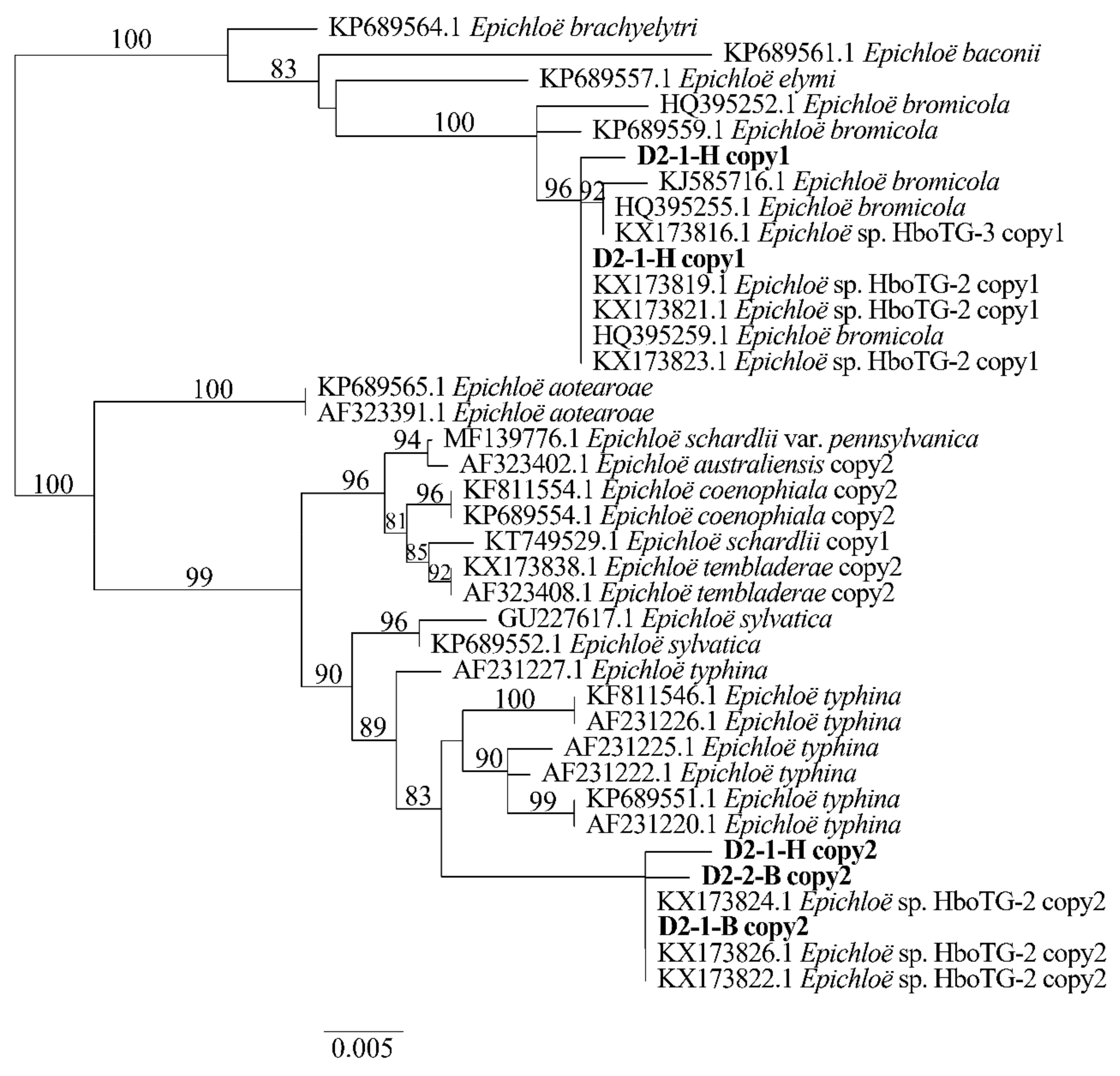
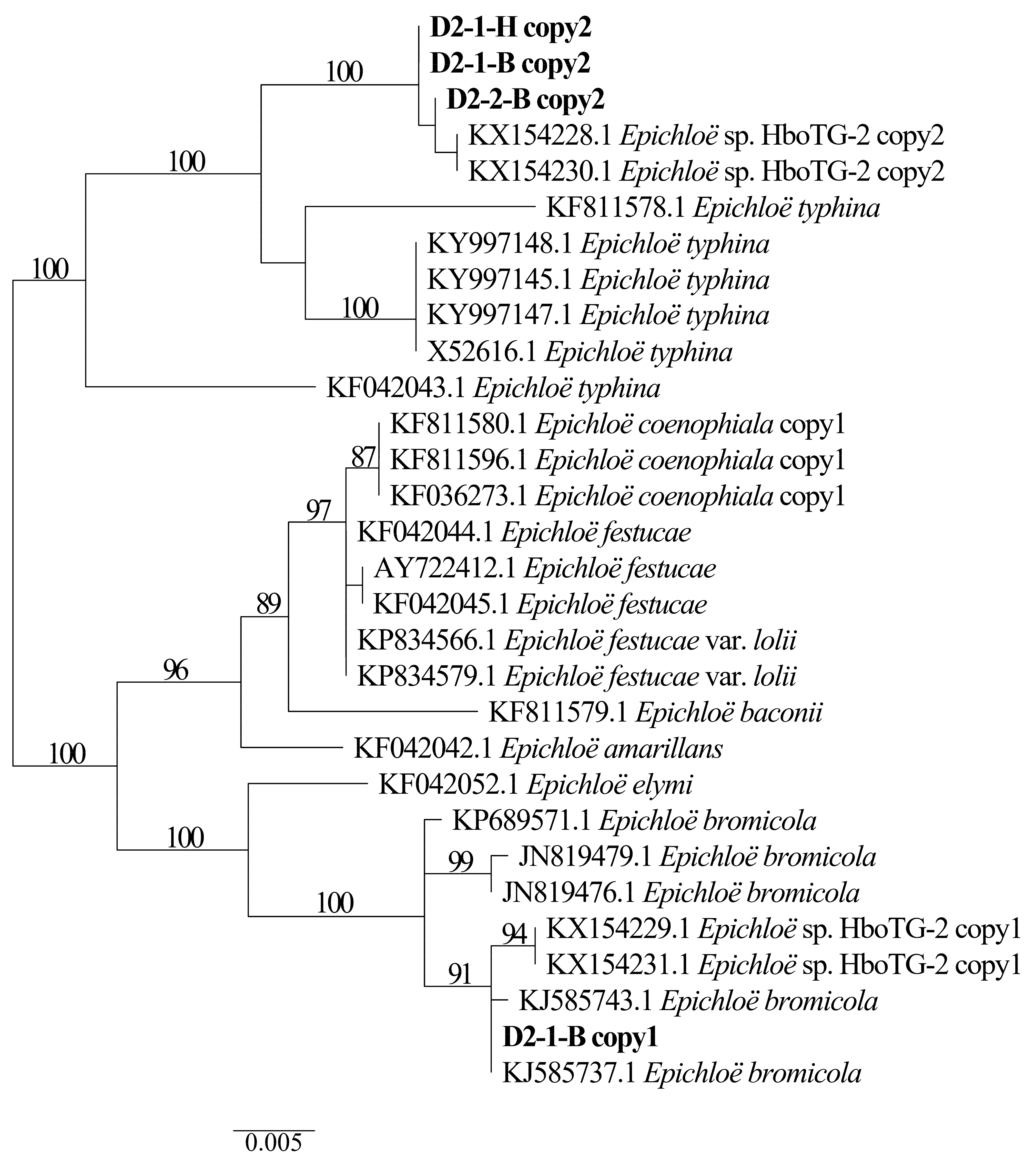
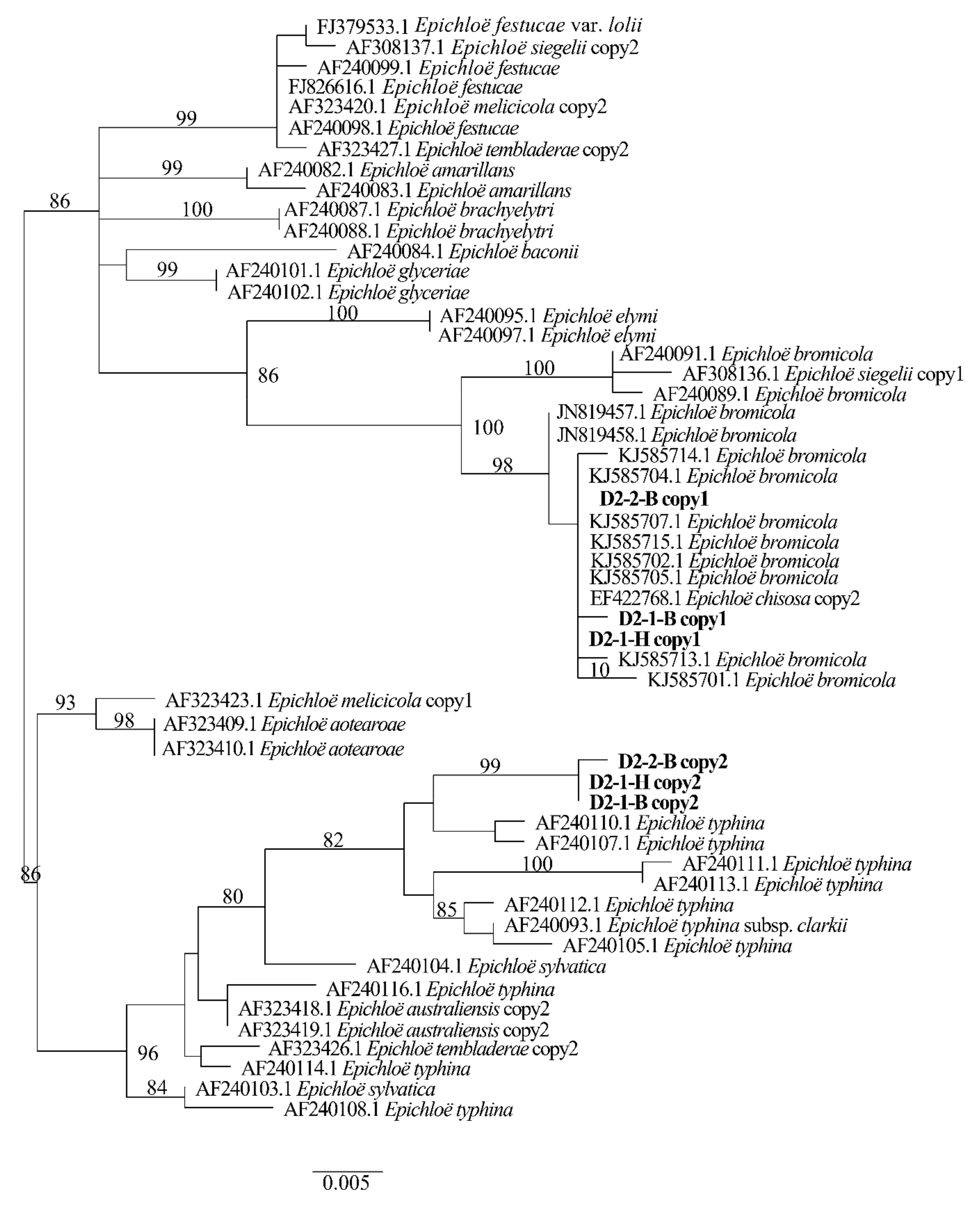

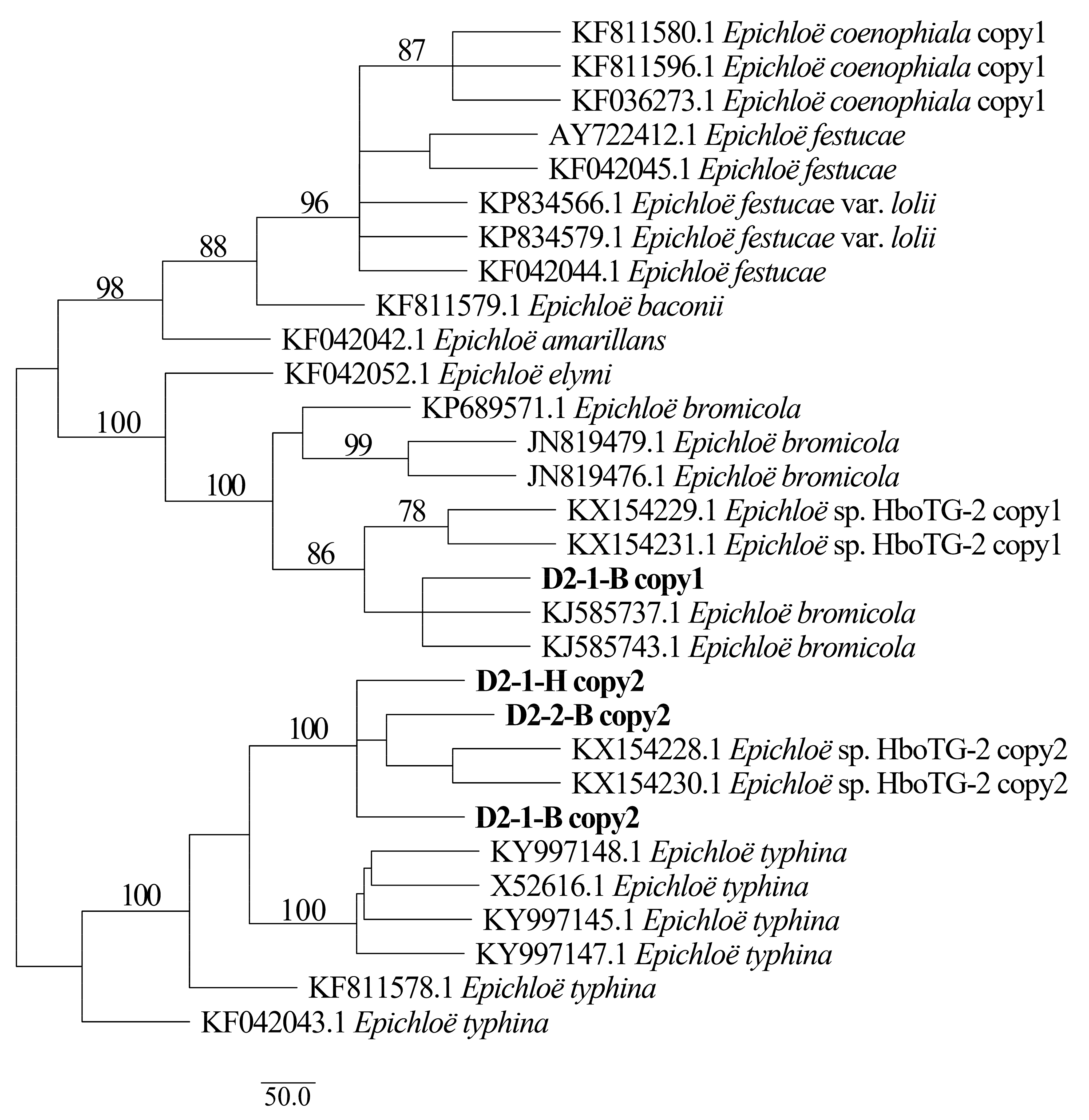
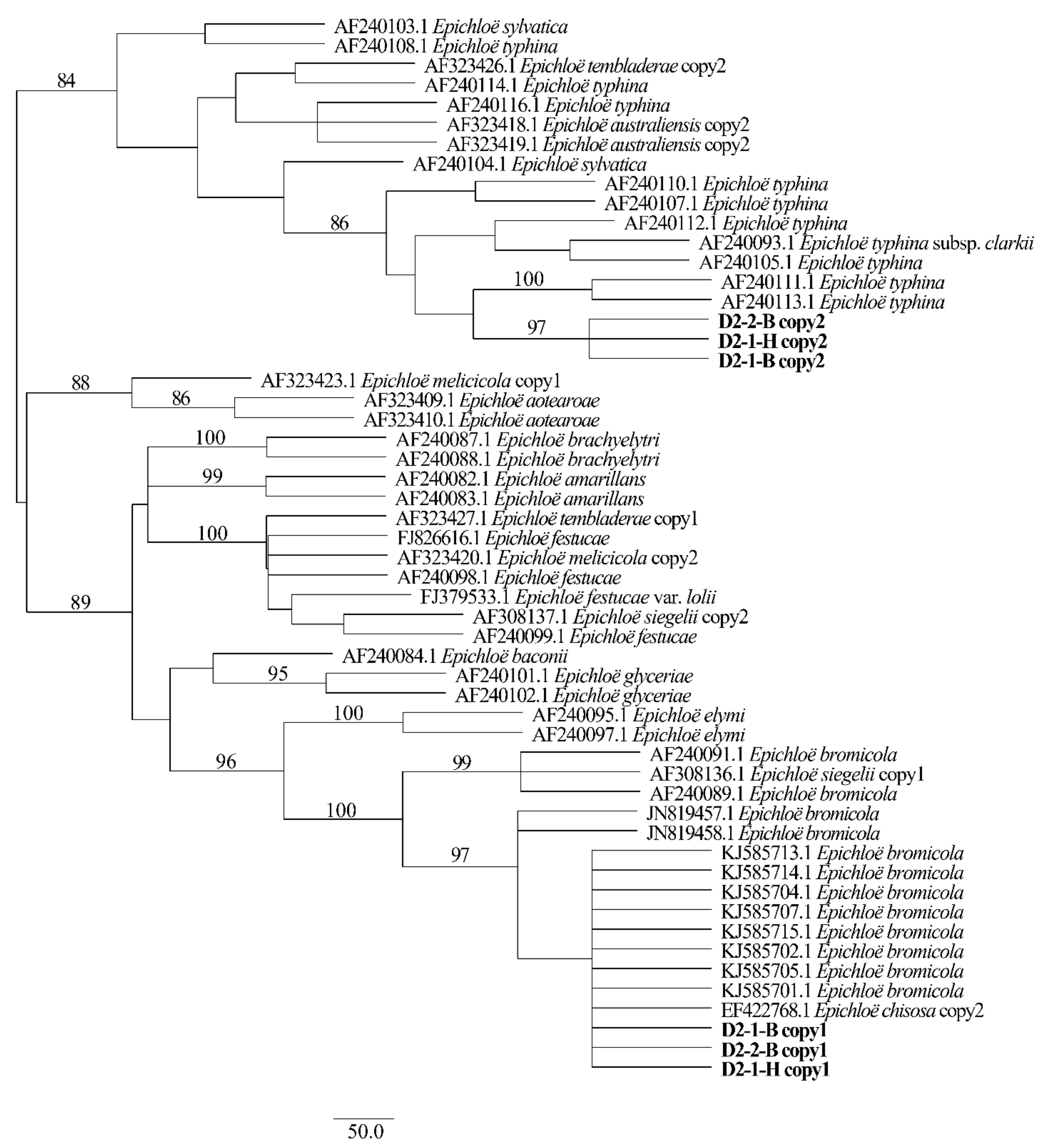
Publisher’s Note: MDPI stays neutral with regard to jurisdictional claims in published maps and institutional affiliations. |
© 2022 by the authors. Licensee MDPI, Basel, Switzerland. This article is an open access article distributed under the terms and conditions of the Creative Commons Attribution (CC BY) license (https://creativecommons.org/licenses/by/4.0/).
Share and Cite
Wang, T.; Chen, T.; White, J.F.; Li, C. Identification of Three Epichloë Endophytes from Hordeum bogdanii Wilensky in China. J. Fungi 2022, 8, 928. https://doi.org/10.3390/jof8090928
Wang T, Chen T, White JF, Li C. Identification of Three Epichloë Endophytes from Hordeum bogdanii Wilensky in China. Journal of Fungi. 2022; 8(9):928. https://doi.org/10.3390/jof8090928
Chicago/Turabian StyleWang, Tian, Taixiang Chen, James F. White, and Chunjie Li. 2022. "Identification of Three Epichloë Endophytes from Hordeum bogdanii Wilensky in China" Journal of Fungi 8, no. 9: 928. https://doi.org/10.3390/jof8090928
APA StyleWang, T., Chen, T., White, J. F., & Li, C. (2022). Identification of Three Epichloë Endophytes from Hordeum bogdanii Wilensky in China. Journal of Fungi, 8(9), 928. https://doi.org/10.3390/jof8090928








